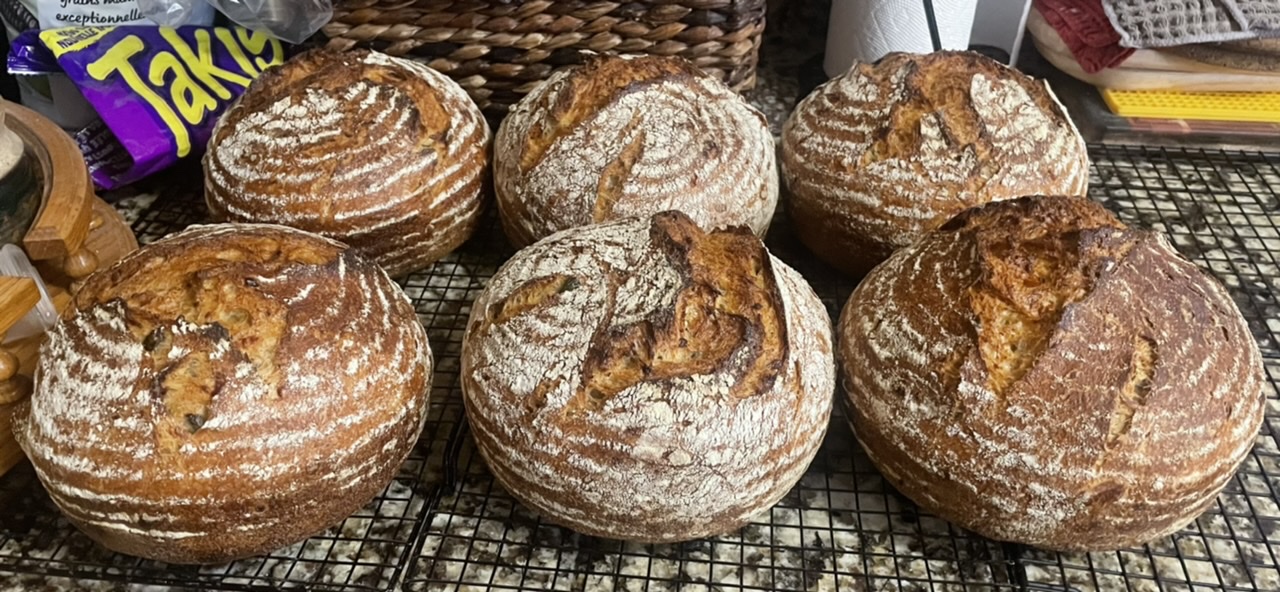Last time I did this one, I used cubed cheese. I thought I’d try it with grated cheese. I also upped the quantities of jalapeños.
Recipe
Makes 3 loaves
Add-ins
55 - 100 g sliced pickled jalapeños (to taste) I put in 80 g
250 g old cheddar cheese, grated
3 g freeze dried chives or 24 g fresh chopped chives
Main Dough
100 g freshly milled Selkirk wheat flour
100 g freshly milled rye flour
100 g freshly milled Red Fife wheat flour
775 g unbleached strong bakers flour
750 g filtered water + 75g
20 g Himalayan pink salt
30 g local yogurt
250 g 100% hydration levain (procedure for this is in recipe)
Extra whole grain and unbleached flour to feed the levain
The night before:
1. Mill the grains on the finest setting of your mill or measure out commercial whole grain flour of the various grains if you don’t mill your own.
2. Place the required amount of each freshly milled flour in a tub and add the unbleached flour to it. Cover and set aside.
3. Grate the cheddar, add a tablespoon of flour and toss with your fingers to separate the shreds. Place in the fridge overnight.
4. Drain the jalapeños and chop them into smaller pieces. Mince the chives if using fresh, put with the jalapeños in a bowl, and refrigerate overnight.
5. Take 10 g of refrigerated starter and feed it 20 g of water and 20 g of wholegrain flour. Let that rise at cool room temperature for the night.
Dough making day:
1. Feed the levain 100 g of filtered water and 50 g of wholegrain flour as well as 50g of strong baker’s flour. Place in a warm spot. Let rise until doubled (about 5 hours). Take the cheese and the chives/jalapeños out of the fridge to warm up before being used in the dough.
2. About two hours before the levain is ready, using a stand mixer, mix the water with the flours, and mix on speed 1 until all the flour has been hydrated. Let this autolyse for a couple of hours.
3. Once the autolyse is done, add the jalapeños, the cheese, the chives, the salt, the yogurt, and the levain to the bowl. Mix on speed one for a minute to integrate everything, then mix on speed 2 for 9 minutes. Add the extra water gradually if needed. Mine needed it.
4. Remove the dough from the mixing bowl and place in a lightly oiled covered tub. Let rest 30 minutes in a warm spot (oven with light on).
5. Do 2 sets of coil folds at 45 minute intervals and then 2 other sets at 30 minute intervals, and then let the dough rise to about 40-50%. It should have irregular bubbles visible through the sides of the container and bubbles on top as well.
6. Tip the dough out on a bare counter, sprinkle the top with flour and divide into portions of ~850 g. Round out the portions into rounds with a dough scraper and let rest 30 minutes on the counter.
7. Do a final shape by flouring the top of the rounds and flipping the rounds over on a lightly floured counter. Gently stretch the dough out into a circle. Pull and fold the third of the dough closest to you over the middle. Pull the right side and fold over the middle and do the same to the left. Fold the top end to the center patting out any cavities. Finally stretch the two top corners and fold over each other in the middle. Roll the bottom of the dough away from you until the seam is underneath the dough. Cup your hands around the dough and pull towards you, doing this on all sides of the dough to round it off. Finally spin the dough to make a nice tight boule.
8. Sprinkle a mix of rice flour and all purpose flour in the bannetons. Place the dough seam side down in the bannetons. Let rest for a few minutes on the counter and then put to bed in a cold (38F) fridge overnight.
Baking Day
1. The next morning, heat the oven to 475F with the Dutch ovens inside for 45 minutes to an hour. Turn out the dough seam side up onto a cornmeal sprinkled counter. Place rounds of parchment paper in the bottom of the pots, and carefully but quickly place the dough seam side up inside.
2. Cover the pots and bake the loaves at 450 F for 25 minutes, remove the lids, and bake for another 22 minutes at 425 F. Internal temperature should be 205 F or more.
Be aware that the loaves might stick to the sides of your pots due to the cheese. If it dors, run a thin knife down the sides to break the stuck spots and with the parchment paper on the bottom, the loaves will pop right out.

